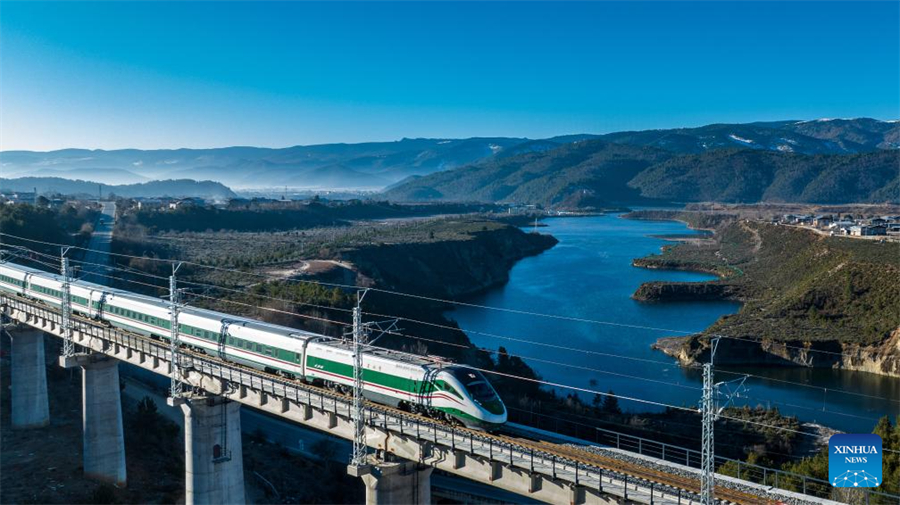New railway linking Lijiang, Shangri-La paves way for high-quality development in southwest China

This aerial photo taken on Nov. 26, 2023 shows a train running along the Lijiang-Shangri-la railway in southwest China's Yunnan Province. A railway linking the cities of Lijiang and Shangri-la, two well-known tourist destinations in southwest China's Yunnan Province, opened to traffic on Sunday, according to local authorities.
by Xinhua writers Wang Changshan, Ding Yiquan, Zhao Zhiqin
KUNMING -- As the railway connecting the captivating cities of Lijiang and Shangri-la in southwest China's Yunnan Province opened to traffic on Sunday, Tibetan guide Senalzui saw her decade-long dream come true.
"The opening of this railway is a monumental moment for me. I'm eager to guide more visitors from distant places through my hometown," said Senalzui, who has been serving as a tour guide for ten years.
With the operation of the Lijiang-Shangri-la railway, the fastest travel time between the two cities will be 1 hour and 18 minutes, spanning a 139-km route that also links Shangri-la, in the Diqing Tibetan Autonomous Prefecture, to the provincial capital, Kunming.
Nestled at the crossroads of Yunnan, Sichuan, and Xizang, Diqing, meaning "auspicious place" in Tibetan, is a sought-after "paradise." It is a place that was severely impoverished, as the region's rugged terrain is carved by rivers such as Jinsha and Lancang, resulting in deep canyons and making road travel challenging.
Residents, grappling with inconvenient road access, traditionally had to rely on costly air travel and lengthy car journeys to descend from the mountains.
The new railway now offers more convenient options. The Lijiang-Shangri-la railway is a crucial segment of the Yunnan-Xizang Railway, ascending from 2,400 meters at Lijiang Station to 3,274 meters at Shangri-la Station.
Such a plateau railway navigates through a region marked by robust crustal tectonic activity, intricate topography, and complex geological conditions, earning it the title of a "geological museum."
The construction, initiated in 2014, posed rare challenges. Through the integration of practical experience, resolution of key engineering challenges, and innovative technological approaches, the railway has been completed and now boasts 20 tunnels and 34 bridges, totaling a length of 102.5 km and covering more than 70 percent of the route.
"The builders have overcome many technical problems and accumulated valuable experience for China's plateau railway construction," said Zhang Minyin, commander of the Western Yunnan Railway Construction Headquarters of China Railway Kunming Bureau Group Co.
The newly opened railway is poised to stimulate the tourism industry's growth, creating additional avenues for diverse ethnic groups to enhance their income.
Zhang Yong, an official with the Lijiang Culture and Tourism Bureau, emphasized the potential synergy among well-known tourist destinations such as Dali, Lijiang, and Diqing in Yunnan. With convenient transportation, these areas can leverage cultural tourism resources for mutual benefit and development.
In the first nine months of this year, Lijiang welcomed nearly 56.78 million visitors, marking a year-on-year surge of 26.09 percent. Also, Diqing attracted over 10 million tourists in the first half of the year.
"Anticipating an influx of more visitors with the operation of the railway, efforts are underway to enhance the quality of scenic spots, boost tourist reception capabilities, and refine employee skills, all aimed at effectively elevating tourist satisfaction," said Pu Xianghong, an official with the Diqing culture and tourism bureau.
The impact of the railway would extend beyond tourism. Shangri-la is rich in mineral resources and characteristic agricultural products. The railway is projected to facilitate the annual export of approximately 300,000 tonnes of copper and iron ore in Shangri-la. Moreover, agricultural products such as matsutake mushrooms are set to utilize the railway, streamlining their journey from the mountains to broader markets.
"Relying on the advantages of convenient, low-cost, and high-efficiency railway transportation, we will drive the industrial development along the route and facilitate cultural exchanges and integrated development of all ethnic groups," said Xia Junsong, director of Yunnan Provincial Department of Transportation.
























